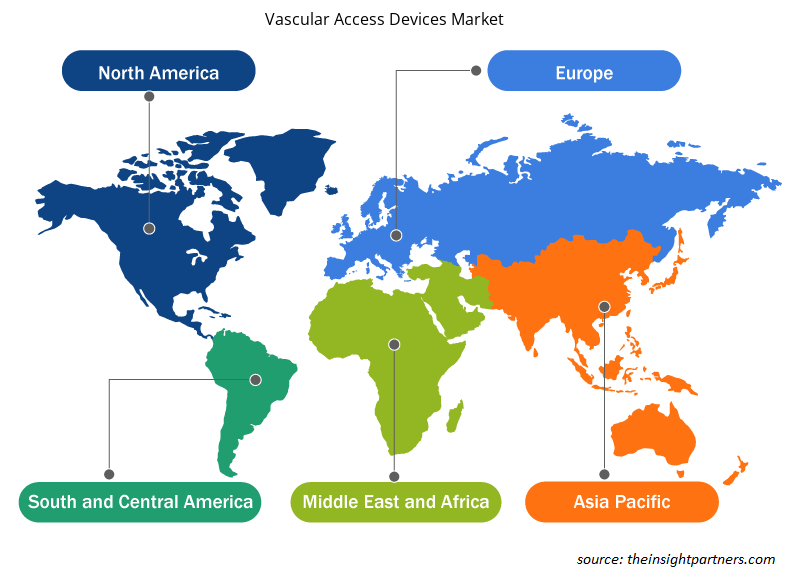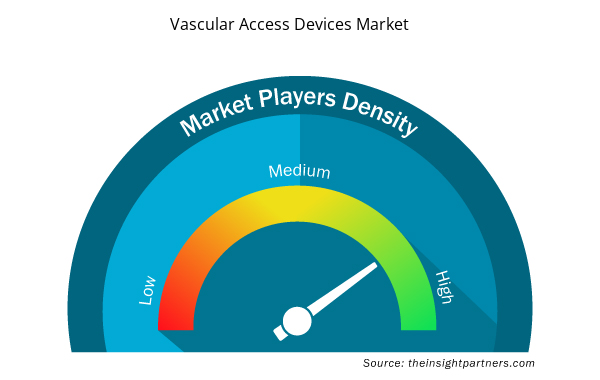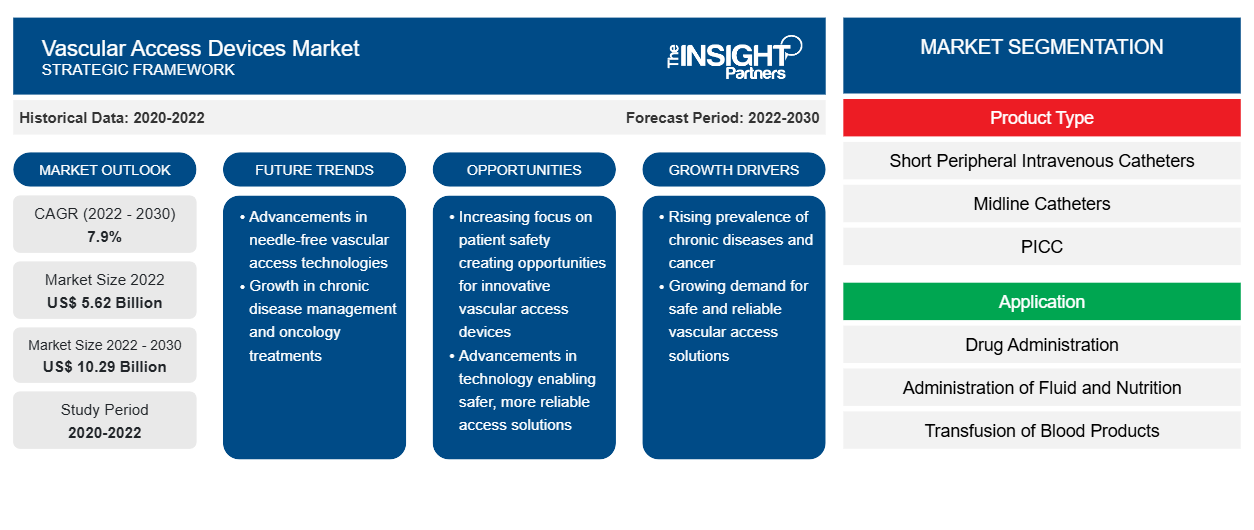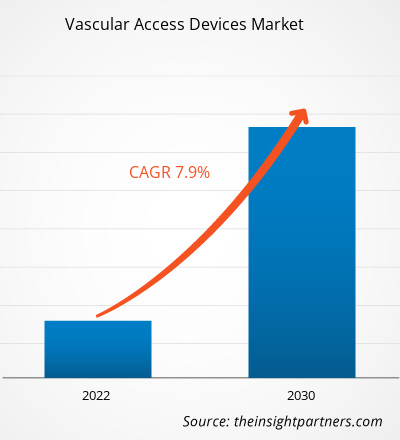[調査レポート] 血管アクセスデバイス市場は2022年に56億2,000万米ドルと評価され、2030年までに102億9,000万米ドルに達すると予測されています。2022年から2030年の間に7.9%のCAGRを記録すると予想されています。
市場洞察とアナリストの見解:
血管アクセス デバイスは、内頸静脈、鎖骨下静脈、外頸静脈、大腿静脈など、上大静脈または下大静脈にアクセスするために、いくつかの解剖学的部位を使用して配置されます。血管アクセスデバイス市場の拡大は、慢性疾患の有病率の上昇と化学療法手順の必要性の高まりによって推進されています。さらに、市場で競争力を維持するための企業の戦略的取り組みが市場の成長を後押ししています。AI 対応ロボット静脈アクセス デバイスの使用が大幅に増加することで、予測期間中に新しい血管アクセス デバイス市場のトレンドがもたらされる可能性があります。
成長の原動力と課題:
化学療法は、強力な薬剤の投与によって腫瘍を縮小または除去するために使用される主要な治療または補助治療です。したがって、がん症例の増加は化学療法手順の需要を促進します。国際がん研究機関(IARC)の推定によると、2020年には世界中で1,930万件の新規がん症例が報告され、約1,000万人ががんにより死亡しました。国立がん登録(NCR)によると、南アフリカでは2020年に約11万人の新規がん症例が診断され、56,000人以上ががん関連で死亡しました。さらに、今後数十年で疾病負担が増加すると予測されており、2030年と2040年までに新規がん症例はそれぞれ138,000件と175,000件に増加すると推定され、がん関連死亡率はこれらの年で73,000人と94,000人に増加すると見込まれています。したがって、がんの罹患率の上昇は血管アクセスデバイス市場の成長を促進します。
要件に合わせてレポートをカスタマイズする
このレポートの一部、国レベルの分析、Excelデータパックなど、あらゆるレポートを無料でカスタマイズできます。また、スタートアップや大学向けのお得なオファーや割引もご利用いただけます。
- このレポートの主要な市場動向を入手してください。この無料サンプルには、市場動向から見積もりや予測に至るまでのデータ分析が含まれます。
レポートのセグメンテーションと範囲:
血管アクセス デバイス市場の分析は、製品タイプ、アプリケーション、挿入経路、エンド ユーザー、および地域というセグメントを考慮して実行されています。製品タイプ別の市場は、短い末梢静脈カテーテル、ミッドライン カテーテル、PICC (末梢挿入中心静脈カテーテル)、中心カテーテル、埋め込み型ポート、およびアクセサリに分類されます。中心カテーテル セグメントの市場は、CICC (中心挿入中心カテーテル)、FICC (大腿挿入中心カテーテル)、その他にさらに分類されます。アプリケーションに基づいて、血管アクセス デバイス市場は、薬物投与、体液および栄養投与、血液製剤の輸血、その他に分類されます。挿入経路に基づいて、市場は皮下と静脈に分岐します。エンド ユーザーに基づいて、市場は病院と診療所、外来手術センター、その他に分類されます。血管アクセスデバイス市場レポートの範囲には、北米(米国、カナダ、メキシコ)、欧州(スペイン、英国、ドイツ、フランス、イタリア、その他の欧州)、アジア太平洋(韓国、中国、日本、インド、オーストラリア、その他のアジア太平洋)、中東およびアフリカ(南アフリカ、サウジアラビア、UAE、その他の中東およびアフリカ)、南米および中米(ブラジル、アルゼンチン、その他の南米および中米)が含まれます。
セグメント分析:
血管アクセスデバイス市場は、製品タイプ別に、短い末梢静脈カテーテル、ミッドラインカテーテル、PICC(末梢挿入中心静脈カテーテル)、中心カテーテル、埋め込み型ポート、およびアクセサリに分類されます。中心カテーテルセグメントの市場は、CICC(中心挿入中心カテーテル)、FICC(大腿挿入中心カテーテル)、その他に細分化されています。2022年には、短い末梢静脈カテーテルセグメントは血管アクセスデバイス市場で最大のシェアを占めており、同じセグメントは2022年から2030年の間に最高のCAGRを記録すると予想されています。
用途に基づいて、血管アクセスデバイス市場は、薬物投与、体液および栄養投与、血液製剤の輸血、その他に分類されます。2022年には、薬物投与セグメントが最大のシェアを占め、2022年から2030年の間に最高のCAGRを記録すると予測されています。
挿入経路に基づいて、血管アクセスデバイス市場は皮下と静脈内に分かれています。静脈内セグメントは2022年に大きな市場シェアを占め、2022年から2030年にかけてより高いCAGRを記録すると予想されています。
エンドユーザー別に見ると、市場は病院・診療所、外来手術センター、その他に分類されます。病院・診療所セグメントの血管アクセスデバイス市場は、2022~2030年にかけて成長する見込みです。
地域分析:
北米は、世界の血管アクセスデバイス市場の成長に最も大きく貢献しています。アジア太平洋地域は、2022年から2030年にかけて市場で最も高いCAGRを記録すると予測されています。慢性疾患の蔓延、高齢者人口の増加、新製品および既存製品の開発に携わる主要な市場プレーヤーの存在、技術の進歩の高まりにより、北米は2022年に世界市場で最大のシェアを占めました。北米では、米国が2022年に最大の市場シェアを占めました。
血管アクセスデバイス市場の地域別分析
予測期間を通じて血管アクセスデバイス市場に影響を与える地域的な傾向と要因は、Insight Partners のアナリストによって徹底的に説明されています。このセクションでは、北米、ヨーロッパ、アジア太平洋、中東、アフリカ、南米、中米にわたる血管アクセスデバイス市場のセグメントと地理についても説明します。

- 血管アクセスデバイス市場の地域別データを入手
血管アクセスデバイス市場レポートの範囲
| レポート属性 | 詳細 |
|---|---|
| 2022年の市場規模 | 56億2千万米ドル |
| 2030年までの市場規模 | 102.9億米ドル |
| 世界のCAGR(2022年 - 2030年) | 7.9% |
| 履歴データ | 2020-2022 |
| 予測期間 | 2022-2030 |
| 対象セグメント | 製品タイプ別
|
| 対象地域と国 | 北米
|
| 市場リーダーと主要企業プロフィール |
|
血管アクセスデバイス市場のプレーヤー密度:ビジネスダイナミクスへの影響を理解する
血管アクセス デバイス市場は、消費者の嗜好の変化、技術の進歩、製品の利点に対する認識の高まりなどの要因により、エンド ユーザーの需要が高まり、急速に成長しています。需要が高まるにつれて、企業は提供内容を拡大し、消費者のニーズを満たすために革新し、新たなトレンドを活用し、市場の成長をさらに促進しています。
市場プレーヤー密度とは、特定の市場または業界内で活動している企業または会社の分布を指します。これは、特定の市場スペースに、その市場規模または総市場価値に対してどれだけの競合相手 (市場プレーヤー) が存在するかを示します。
血管アクセスデバイス市場で事業を展開している主要企業は次のとおりです。
- テレフレックス株式会社
- BD
- B.ブラウンSE
- テルモメディカル株式会社
- メドトロニック
免責事項:上記の企業は、特定の順序でランク付けされていません。

- 血管アクセスデバイス市場のトップキープレーヤーの概要を入手
業界の発展と将来の機会:
血管アクセスデバイス市場の予測は、主要な企業の出版物、協会データ、データベースなど、さまざまな二次および一次研究結果に基づいて推定されます。主要な市場プレーヤーが発表したプレスリリースによると、いくつかの戦略が以下にリストされています。
- 2023 年 11 月、BD (Becton, Dickinson, and Company) は、統合カテーテルと互換性のある新しい無針採血技術を発売しました。これは、同社の「ワンスティック入院」ビジョンの実現に役立ちます。PIVO Pro 無針採血デバイスは、NearPort IV アクセスを備えた新しい Nexiva クローズド IV カテーテル システムを含む、統合型および長い末梢 IV カテーテルとの互換性を実現するために設計が改良されています。
- 2023 年 5 月、Teleflex Inc. は、PICC 挿入手順を強化し、合併症の可能性を減らすように設計された 2 つの新しいデバイス、Arrow VPS Rhythm DLX デバイスと NaviCurve Stylet を発売しました。VPS Rhythm DLX デバイスは、患者の心臓の電気活動を使用して、カテーテルの先端の位置情報をリアルタイムで提供します。NaviCurve Stylet は、患者の解剖学的曲線と柔軟な先端を特徴としており、PICC を上大静脈 (SVC) に進めて挿入を成功させるために、患者の解剖学的構造に合わせて自動的に方向を変えるように設計されています。
競争環境と主要企業:
Teleflex Inc、BD、B. Braun SE、Terumo Medical Corporation、Medtronic、Fresenius Kabi、Baxter、Vygon SAS、Kimal、Access Vascular Inc は、血管アクセス デバイス市場レポートで紹介されている主要企業の一部です。さらに、市場とそのエコシステムの全体像を把握するために、調査中に他の複数の企業を調査および分析しました。これらの企業は、世界中の消費者からの高まる需要を満たし、専門ポートフォリオの製品範囲を拡大するために、地理的拡大と新製品の発売に重点を置いています。グローバルなプレゼンスにより、大規模な顧客ベースにサービスを提供でき、その結果、市場の拡大が促進されます。
- 過去2年間の分析、基準年、CAGRによる予測(7年間)
- PEST分析とSWOT分析
- 市場規模価値/数量 - 世界、地域、国
- 業界と競争環境
- Excel データセット


- Grant Management Software Market
- Photo Printing Market
- Pharmacovigilance and Drug Safety Software Market
- Biopharmaceutical Tubing Market
- Nuclear Decommissioning Services Market
- Airline Ancillary Services Market
- Biopharmaceutical Contract Manufacturing Market
- Europe Tortilla Market
- Unit Heater Market
- Retinal Imaging Devices Market

Report Coverage
Revenue forecast, Company Analysis, Industry landscape, Growth factors, and Trends

Segment Covered
This text is related
to segments covered.

Regional Scope
North America, Europe, Asia Pacific, Middle East & Africa, South & Central America

Country Scope
This text is related
to country scope.
よくある質問
Based on geography, the vascular access devices market is segmented into North America (the US, Canada, and Mexico), Europe (the UK, Germany, France, Italy, Spain, and the Rest of Europe), Asia Pacific (China, Japan, India, South Korea, Australia, and the Rest of Asia Pacific), the Middle East & Africa (the UAE, Saudi Arabia, South Africa, and Rest of the Middle East & Africa), and South & Central America (Brazil, Argentina, and the Rest of South & Central America). North America is the largest contributor to the growth of the global vascular access devices market. Asia Pacific is expected to register the highest CAGR in the vascular access devices market during 2022–2030.
The vascular access devices market majorly consists of the players such Teleflex Inc, BD, B. Braun SE, Terumo Medical Corporation, Medtronic, Fresenius Kabi, Baxter, Vygon SAS, Kimal, and Access Vascular Inc
The vascular access devices market, by treatment type, is segmented into short peripheral intravenous catheters, midline catheters, PICC (peripherally inserted central catheters), central catheter, implantable ports, and accessories. Central catheter is further divided into CICC (centrally inserted central catheter), FICC (femorally inserted central catheter), and others. In 2022, the short peripheral intravenous catheter segment held the largest vascular access devices market share and is expected to record the highest CAGR during 2022–2030.
Based on application, the market is segmented into drug administration, administration of fluid & nutrition, transfusion of blood products, and others. In 2022, the drug administration segment held the largest vascular access devices market share and is projected to record the highest CAGR during 2022–2030.
Based on route of insertion, the market is bifurcated into subcutaneous and intravenous. The intravenous segment held a larger share of the vascular access devices market in 2022 and is anticipated to record a higher CAGR during 2022–2030.
Based on end user, the market is divided into hospitals and clinics, ambulatory surgical center, and others. The vascular access devices market size for the hospitals and clinics segment is likely to surge during 2022–2030.
Vascular access devices are placed using a number of anatomic sites to access the superior or inferior vena cava: the internal jugular vein, subclavian vein, external jugular vein, and femoral vein. The growing market size is attributed to the increasing prevalence of chronic diseases and increasing chemotherapy procedures. In addition, strategic initiatives by companies to stay competitive in the market are fueling the market growth. Significant increase in use of AI-enabled robotic venous access devices is likely to bring new vascular access devices market trends during the forecast period.
The increasing cases of chronic disorders and growing demand of chemotherapy procedures are factors predominently driving the vascular access devices market size. However, the high cost associated with placement of vascular access devices hinders the market growth.
Trends and growth analysis reports related to Life Sciences : READ MORE..
The List of Companies - Vascular Access Devices Market
- Teleflex Inc
- BD
- B. Braun SE
- Terumo Medical Corporation
- Medtronic
- Fresenius Kabi
- Baxter
- Vygon SAS
- Kimal
- Access Vascular Inc
The Insight Partners performs research in 4 major stages: Data Collection & Secondary Research, Primary Research, Data Analysis and Data Triangulation & Final Review.
- Data Collection and Secondary Research:
As a market research and consulting firm operating from a decade, we have published and advised several client across the globe. First step for any study will start with an assessment of currently available data and insights from existing reports. Further, historical and current market information is collected from Investor Presentations, Annual Reports, SEC Filings, etc., and other information related to company’s performance and market positioning are gathered from Paid Databases (Factiva, Hoovers, and Reuters) and various other publications available in public domain.
Several associations trade associates, technical forums, institutes, societies and organization are accessed to gain technical as well as market related insights through their publications such as research papers, blogs and press releases related to the studies are referred to get cues about the market. Further, white papers, journals, magazines, and other news articles published in last 3 years are scrutinized and analyzed to understand the current market trends.
- Primary Research:
The primarily interview analysis comprise of data obtained from industry participants interview and answers to survey questions gathered by in-house primary team.
For primary research, interviews are conducted with industry experts/CEOs/Marketing Managers/VPs/Subject Matter Experts from both demand and supply side to get a 360-degree view of the market. The primary team conducts several interviews based on the complexity of the markets to understand the various market trends and dynamics which makes research more credible and precise.
A typical research interview fulfils the following functions:
- Provides first-hand information on the market size, market trends, growth trends, competitive landscape, and outlook
- Validates and strengthens in-house secondary research findings
- Develops the analysis team’s expertise and market understanding
Primary research involves email interactions and telephone interviews for each market, category, segment, and sub-segment across geographies. The participants who typically take part in such a process include, but are not limited to:
- Industry participants: VPs, business development managers, market intelligence managers and national sales managers
- Outside experts: Valuation experts, research analysts and key opinion leaders specializing in the electronics and semiconductor industry.
Below is the breakup of our primary respondents by company, designation, and region:

Once we receive the confirmation from primary research sources or primary respondents, we finalize the base year market estimation and forecast the data as per the macroeconomic and microeconomic factors assessed during data collection.
- Data Analysis:
Once data is validated through both secondary as well as primary respondents, we finalize the market estimations by hypothesis formulation and factor analysis at regional and country level.
- Macro-Economic Factor Analysis:
We analyse macroeconomic indicators such the gross domestic product (GDP), increase in the demand for goods and services across industries, technological advancement, regional economic growth, governmental policies, the influence of COVID-19, PEST analysis, and other aspects. This analysis aids in setting benchmarks for various nations/regions and approximating market splits. Additionally, the general trend of the aforementioned components aid in determining the market's development possibilities.
- Country Level Data:
Various factors that are especially aligned to the country are taken into account to determine the market size for a certain area and country, including the presence of vendors, such as headquarters and offices, the country's GDP, demand patterns, and industry growth. To comprehend the market dynamics for the nation, a number of growth variables, inhibitors, application areas, and current market trends are researched. The aforementioned elements aid in determining the country's overall market's growth potential.
- Company Profile:
The “Table of Contents” is formulated by listing and analyzing more than 25 - 30 companies operating in the market ecosystem across geographies. However, we profile only 10 companies as a standard practice in our syndicate reports. These 10 companies comprise leading, emerging, and regional players. Nonetheless, our analysis is not restricted to the 10 listed companies, we also analyze other companies present in the market to develop a holistic view and understand the prevailing trends. The “Company Profiles” section in the report covers key facts, business description, products & services, financial information, SWOT analysis, and key developments. The financial information presented is extracted from the annual reports and official documents of the publicly listed companies. Upon collecting the information for the sections of respective companies, we verify them via various primary sources and then compile the data in respective company profiles. The company level information helps us in deriving the base number as well as in forecasting the market size.
- Developing Base Number:
Aggregation of sales statistics (2020-2022) and macro-economic factor, and other secondary and primary research insights are utilized to arrive at base number and related market shares for 2022. The data gaps are identified in this step and relevant market data is analyzed, collected from paid primary interviews or databases. On finalizing the base year market size, forecasts are developed on the basis of macro-economic, industry and market growth factors and company level analysis.
- Data Triangulation and Final Review:
The market findings and base year market size calculations are validated from supply as well as demand side. Demand side validations are based on macro-economic factor analysis and benchmarks for respective regions and countries. In case of supply side validations, revenues of major companies are estimated (in case not available) based on industry benchmark, approximate number of employees, product portfolio, and primary interviews revenues are gathered. Further revenue from target product/service segment is assessed to avoid overshooting of market statistics. In case of heavy deviations between supply and demand side values, all thes steps are repeated to achieve synchronization.
We follow an iterative model, wherein we share our research findings with Subject Matter Experts (SME’s) and Key Opinion Leaders (KOLs) until consensus view of the market is not formulated – this model negates any drastic deviation in the opinions of experts. Only validated and universally acceptable research findings are quoted in our reports.
We have important check points that we use to validate our research findings – which we call – data triangulation, where we validate the information, we generate from secondary sources with primary interviews and then we re-validate with our internal data bases and Subject matter experts. This comprehensive model enables us to deliver high quality, reliable data in shortest possible time.


 このレポートの無料サンプルを入手する
このレポートの無料サンプルを入手する